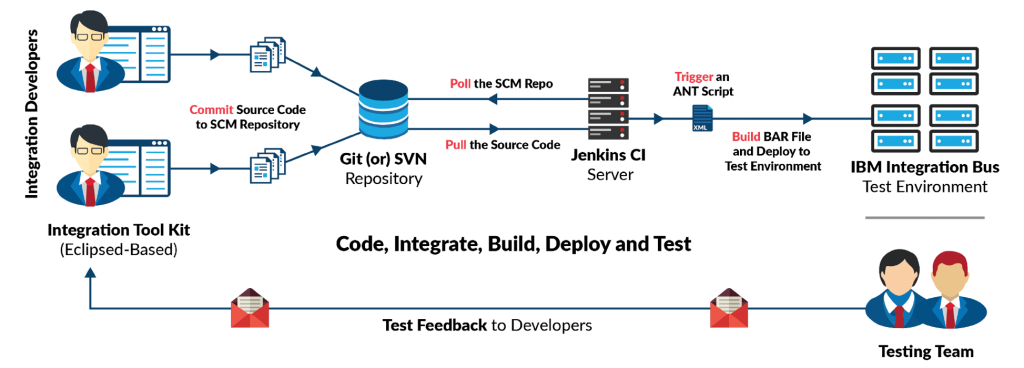In today’s consumer-centric world, it is crucial for enterprises to be able to adopt a Digital Approach. The explosion of Mobile and Social usage has led to the market place becoming extremely competitive and fast-moving. In such a demanding environment, it is very important for organizations to be able to make changes in an agile and flexible manner, else risk being displaced by a competitor who got it right.
What is Continuous Integration?
Continuous Integration (CI) is a development practice that requires developers to integrate code into a shared repository several times a day. Each check-in is then verified by an automated build, allowing teams to detect problems early. By integrating regularly, you can detect errors quickly, and locate them more easily and can also receive constant feedback on the status of the code.
Jenkins is an open-source continuous integration software tool written in the Java programming language for testing and reporting on isolated changes in a larger code base in real-time. It helps to enable developers to find and solve defects in a code base rapidly and to automate testing of their builds.
The Open Source Way
And the technology that you need to automate your deployment process is available today. Our experts have used Enterprise-Class Open Source Technologies to enable the Continuous and Automated Deployments of Enterprise Application changes.
The following technologies were used,
- Jenkins CI
- Git(Code Versioning)
- IBM Integration Bus v10.0
- ANT Scripts
The Business Challenge
In software development, team members spend weeks, months (or) even longer, verifying that their applications work just prior to releasing them. That time spent ‘integrating’ changes is frequently torturous. Developers would kill to have an automated process to help track bugs made over the past few months in a large codebase.
An enormous amount of time is wasted trying to merge incompatible changes from different developers, which ultimately lead to storms of constantly broken builds and applications. A good version control system can help to shed some light on the nature of the bugs encountered during integration, but frequently fixing these incompatibilities is a horror story.
Bad memory of developers, not so good commit comments and lack of versioning the integrations is not a good practice for emerging Digital Enterprise. Such a system can restrict innovation, collaboration, flexibility and agility of an enterprise.
This is a RED LIGHT for any Digital Enterprise.
Flexibility in your IIB Deployments
Many Integration Developers have the same difficulties in making rapid changes to Integration Flows in IBM’s Integration Bus as well. The lack of collaboration between Dev and Ops can make a small change expand to a 2-month project.
In our solution, we use Jenkins, Git, and Ant, to automate the versioning, deployment and testing of an Integration Flow. This helps to promote collaborative changes, smaller change cycles, and rapid testing and deployment of changes.
The Continuous Integration Approach
Jenkins, an Open Source Continuous Integration Tool, helps to automate the process of versioned builds and promotes rapid changes and testing for the enterprise. The basic functionality of Jenkins is to execute a pre-defined list of steps, which are executed, based on a certain trigger.

Why consider smaller changes?
With consumer’s of Digital Applications becoming ever-demanding, enterprises need to enable themselves to make rapid changes without having to wait for long change cycles. With the Continuous Integration Solution enterprises can experience,
- Experience a collaborative environment through a Central Version Control Management System
- Detect bugs and incompatibilities quickly with smaller commits and changes
- Deploy changes rapidly to Test Environment rather than having to wait for large coordinated deployments
- Enable a much more innovative environment for developers to rapidly try their ideas





